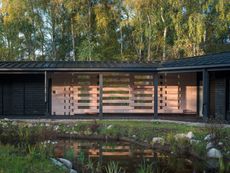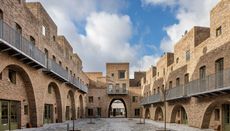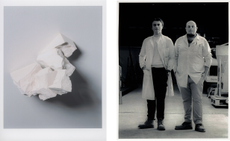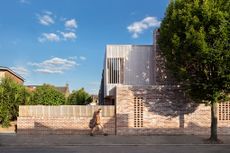Japanese architect Arata Isozaki wins the Pritzker Prize 2019
- (opens in new tab)
- (opens in new tab)
- (opens in new tab)
- Sign up to our newsletter Newsletter
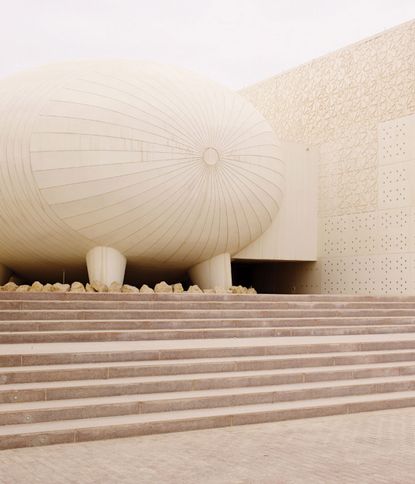
Arata Isozaki has won the Pritzker Prize 2019. The Japanese architect, born in 1931, is known for his style that combines postmodernism and metabolism with technology. His work has shaped public life across the world through a focus on cultural architecture from concert halls in Kyoto, Barcelona and Thessaloniki, to museums and art galleries such as the Museum of Contemporary Art (MOCA) Los Angeles. Isozaki is the 46th laureate and eighth architect from Japan to win the Pritzker Prize.
His architectural work has now spanned six decades and the Prizker jury recognise him for his contribution to pioneering a global approach to architecture. ‘Isozaki was one of the first Japanese architects to build outside of Japan during a time when western civilizations traditionally influenced the East, making his architecture—which was distinctively influenced by his global citizenry—truly international. In a global world, architecture needs that communication,’ said Tom Pritzker, chairman of the Hyatt Foundation.
‘I wanted to see the world through my own eyes, so I traveled around the globe at least ten times before I turned thirty’ – Arata Isozaki
Isozaki set up his own practice, Arata Isozaki & Associates in 1963, after studying at the University of Tokyo and developing his professional knowlegde working under Kenzo Tange. He set up a branch of his practice in Italy in 2005 with Andrea Maffei, which reflected his experience of working across continents and successfully bridging cultures through architecture by designing contextually-specific solutions for each project.
‘I wanted to see the world through my own eyes, so I traveled around the globe at least ten times before I turned thirty. I wanted to feel the life of people in different places and visited extensively inside Japan, but also to the Islamic world, villages in the deep mountains of China, South East Asia, and metropolitan cities in the U.S. I was trying to find any opportunities to do so, and through this, I kept questioning, "what is architecture?"’ says Isozaki.
His notable works include the Ōita Prefectural Library, Japan, completed in 1966; the MOCA, Los Angeles, completed in 1986; the Kyoto Concert Hall, completed in 1995; the Shenzhen Cultural Centre, completed 2007; and the Allianz Tower in Milan, completed in 2015 with his partner Andrea Maffei.

Palau Sant Jordi at Montjuic, Barcelona, Spain, 1990.
One of his most well-known works, the Art Tower in Mito in Ibaraki, Japan completed in 1990. Rising like an electrical charge nearly 100m into the sky, this tower is part of an arts complex in Mito, Japan that includes a concert hall, theatre and a contemporary art gallery. The landmark geometric tower is based on the tetra-helix shape. The piece was commissioned by Mito City, located 120km from Tokyo, to celebrate its 100th anniversary.
He designed the Palau Sant Jordi at Montjuic, Barcelona, for the Barcelona Olympic Games also in 1990. This sporting arena has become a social, sporting and musical hub for the city – holding 24,000 in its concert hall. Sitting atop the Montjuic mountain, it is a friendly, curving form that sought to fuse influence of the east and west to create a new sense of international modernity. It also made sure to reach the highest technical achievement through modern engineering, including the use of mechanised materials for a flexible venue that is still central to the life of the city today.
Considered the highest architectural accolade, the annual Pritzker award honours ‘a living architect or architects whose built work demonstrates a combination of those qualities of talent, vision, and commitment, which has produced consistent and significant contributions to humanity and the built environment through the art of architecture’ and consists of a prize of $100,000 (US) and a bronze medallion.

The Art Tower in Mito by Isozaki, Ibaraki, Japan, 1990.
INFORMATION
For more information, visit the Pritzker Prize website (opens in new tab)
-
 Men’s Fashion Week A/W 2023: what to expect
Men’s Fashion Week A/W 2023: what to expectWe look forward to Men’s Fashion Week A/W 2023 with must-watch moments from Martine Rose, Gucci, Louis Vuitton and more at Pitti Uomo, Milan and Paris
By Jack Moss • Published
-
 Shellmet: the helmet made from waste scallop shells
Shellmet: the helmet made from waste scallop shellsShellmet is a new helmet design by TBWA\Hakuhodo’s creative team and Osaka-based Koushi Chemical Industry Co, made using Hokkaido’s discarded scallop shells
By Jens H Jensen • Published
-
 Jewellery designers to know in 2023, as tipped by Wallpaper’s Hannah Silver
Jewellery designers to know in 2023, as tipped by Wallpaper’s Hannah SilverJewellery designers to know in 2023: Wallpaper* watches & jewellery editor Hannah Silver on those set to shine
By Hannah Silver • Published
-
 RIAS’ Doolan Award 2022 goes to Quarry Studios by Moxon Architects
RIAS’ Doolan Award 2022 goes to Quarry Studios by Moxon ArchitectsQuarry Studios by Moxon Architects scoops RIAS’ Doolan Award 2022
By Ellie Stathaki • Published
-
 The 2022 RIBA house of the year is among these homes
The 2022 RIBA house of the year is among these homesThe hunt for 2022 RIBA House of the Year is starting, and this longlist contains the home that will be crowned the winner on 7 December – watch as the judges whittle down a shortlist weekly
By Ellie Stathaki • Published
-
 Peter Barber is the Soane Medal 2022 winner
Peter Barber is the Soane Medal 2022 winnerThe Soane Medal 2022 winner is announced as London-based architect Peter Barber
By Ellie Stathaki • Last updated
-
 Jeanne Gang scoops 2023 Charlotte Perriand Award
Jeanne Gang scoops 2023 Charlotte Perriand AwardThe 2023 Charlotte Perriand Award goes to American architect Jeanne Gang
By Ellie Stathaki • Last updated
-
 Seratech’s innovative sustainable cement wins Obel award 2022
Seratech’s innovative sustainable cement wins Obel award 2022The 2022 Obel Award goes to Seratech’s carbon-neutral composite cement
By Harriet Thorpe • Last updated
-
 Activism award 2022 is up for grabs
Activism award 2022 is up for grabsThe Archiboo Awards' Activism category competition has launched for 2022
By Ellie Stathaki • Last updated
-
 Feast your eyes on the 2022 RIBA House of the Year longlist
Feast your eyes on the 2022 RIBA House of the Year longlistThe 2022 RIBA House of the Year longlist has been released
By Ellie Stathaki • Last updated
-
 2022 RIBA National Awards: meet the UK’s best new buildings
2022 RIBA National Awards: meet the UK’s best new buildingsMeet the 2022 RIBA National Awards winners, a list that aims to highlight some of the UK’s best new buildings
By Ellie Stathaki • Last updated



